Posey's Tips & Tricks
Troubleshooting 101: How To Know if Office 365 Is Having Problems
It's easy enough to tell if Office 365 is having performance issues (or is plain down). It's a litle harder to figure out whether the problem is with Microsoft or with you.
Most of the time, Office 365 seems to be pretty reliable. Every once in a while, though, just like anything else, Microsoft's cloud can experience the occasional problem. You may have even noticed some of the Office 365 service disruptions that have occurred over the past few years, or even the one this past week.
Whenever I experience an Office 365 outage, I always catch myself wondering if Microsoft is having problems or if the problem is on my end. I live in a rural area and Internet connectivity is not always the most reliable. Last week, for instance, my Internet connection was down for at least 10 hours, possibly longer.
If Office 365 begins to behave badly, there are a few different tools that you can use to determine whether the problem is on your end or Microsoft's.
The quickest and easiest of these tools is the Service Health tool. To access this tool, log into the Office 365 portal and then open the Office 365 Admin Center. As you can see in Figure 1, the dashboard presented on the Home tab includes a listing for Service Health. In the figure, the Service Health pane is currently reporting one issue.
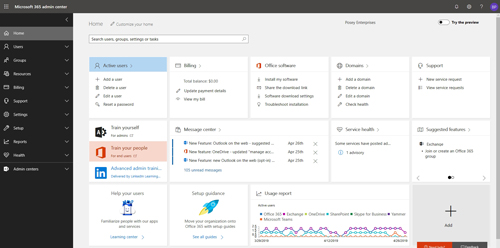 [Click on image for larger view.] Figure 1: Microsoft is currently reporting one service health issue.
[Click on image for larger view.] Figure 1: Microsoft is currently reporting one service health issue.
Before I go on, I want to quickly point out that a service health issue does not necessarily mean that an outage has occurred. Most of the service health issues that I have seen reported over the years are indications of potentially degraded performance, not an outage.
It's also worth mentioning that just because Microsoft indicates that performance may be degraded, it does not necessarily mean that you will notice anything different from the normal level of performance. In those situations, the indicator is telling you that your performance may be impacted, not necessarily that it will be impacted.
If you want to see what is going on, just click on the health issue. What you will see next depends on the type of issue that is occurring. As you can see in Figure 2, this particular issue is just an advisory for Skype for Business.
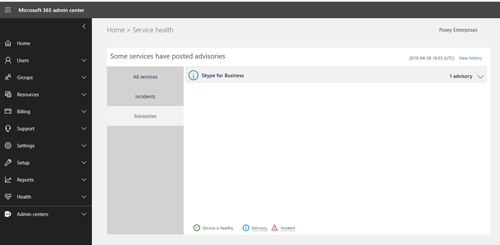 [Click on image for larger view.] Figure 2: There is currently an advisory for Skype for Business.
[Click on image for larger view.] Figure 2: There is currently an advisory for Skype for Business.
If I expand the advisory, you can see that right now Microsoft is having an issue in which service is degraded, and some Office 365 users may be unable to create Skype for Business meetings through Outlook. You can see the full advisory text in Figure 3.
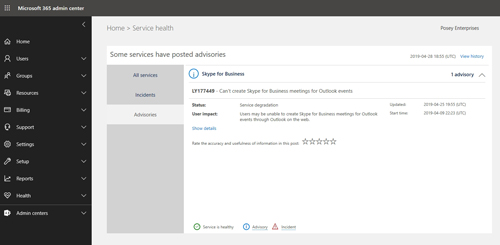 [Click on image for larger view.] Figure 3: Here is a description of the issue.
[Click on image for larger view.] Figure 3: Here is a description of the issue.
As you look at the figures above, you will notice that there are tabs for advisories and for incidents. An incident is more serious but less common than an advisory. You will also notice that there is a tab for All Services. The All Services tab contains a summary of Office 365's overall health. As you can see in Figure 4, the All Services tab lists each one of the Office 365 services, along with a simple statement of whether or not the service is currently healthy. If there is an advisory or an incident for a service, those will be hyperlinked, as shown below.
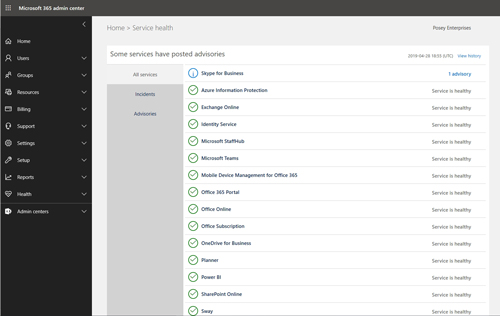 [Click on image for larger view.] Figure 4: The All Services screen reports on the health of all of the Office 365 services.
[Click on image for larger view.] Figure 4: The All Services screen reports on the health of all of the Office 365 services.
The Service Health screen can be really helpful for figuring out whether or not Microsoft is currently having problems with Office 365. However, the one disadvantage in relying on the Service Health screen is that it requires you to actually log into Office 365. What happens if you are having trouble logging in or if you can't open the Office 365 Admin Center?
In those types of situations, I like using a third-party tool called Downdetector, a Web site that reports on the service health of popular SaaS applications such as Office 365. As you can see in Figure 5, Downdetector shows you problems that have recently been reported, the number of problems reported in the last 24 hours and even an outage map.
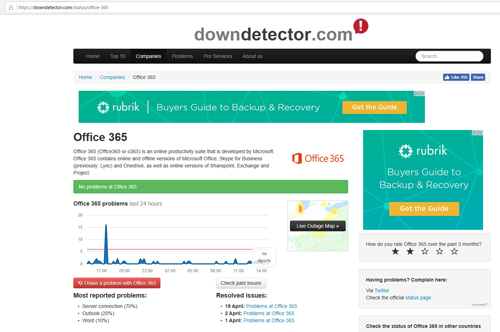 [Click on image for larger view.] Figure 5: Downdetector is an alternative tool for assessing Office 365's health.
[Click on image for larger view.] Figure 5: Downdetector is an alternative tool for assessing Office 365's health.
In case you are wondering, Downdetector reports on issues with hundreds of different sites. The service covers everything from Dish Network to DuckDuckGo.
About the Author
Brien Posey is a 22-time Microsoft MVP with decades of IT experience. As a freelance writer, Posey has written thousands of articles and contributed to several dozen books on a wide variety of IT topics. Prior to going freelance, Posey was a CIO for a national chain of hospitals and health care facilities. He has also served as a network administrator for some of the country's largest insurance companies and for the Department of Defense at Fort Knox. In addition to his continued work in IT, Posey has spent the last several years actively training as a commercial scientist-astronaut candidate in preparation to fly on a mission to study polar mesospheric clouds from space. You can follow his spaceflight training on his Web site.